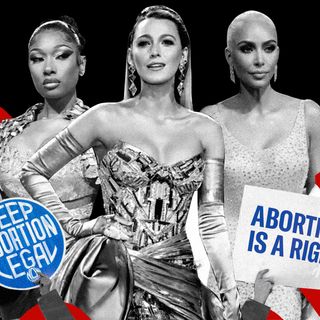
Grace and Frankie’s Record‑Breaking Run Shows People Are Willing To Watch Women Explore Sex, Romance in Their 70s
The show proves that depictions of female friendships don’t need to be restricted to young, airbrushed women, who discuss little other than relationships and fashion.

Grace and Frankie premiered in 2015; seven years and seven seasons later, it’s coming to an end. I began watching Netflix’s longest-running original to date when I was still in college; now, a few shifts in cities and careers later, I’m binging its final season — preparing to miss the chemistry between Jane Fonda and Lily Tomlin as its titular leads, Grace and Frankie, respectively.
Interestingly, people of all ages — even 20-to-30-somethings — contributed to the viewership of a show about women in their 70s navigating sex, romance, and everything else pop culture has kept us from picturing “older” women doing. Grace and Frankie‘s generationally-diverse fanbase proves that people are willing to watch “older” women break taboos on-screen — episode after episode. And herein lies the good news: shows about female friendships don’t need to be restricted to depictions of young, airbrushed women, who discuss little other than relationships and fashion, and are either embarrassed by anything remotely related to bowel movements or pretend like they have no use for a toilet other than chatting in its privacy.
“Pop culture has long taught us that the worst possible thing that could happen to a woman is for her to end up alone… By those standards, the premise of Grace and Frankie should have been the beginning of the end for its main characters: two septuagenarian frenemies discovering that their husbands had been having an affair for two decades,” Rachael Sigee wrote in The Guardian. Instead, the show became what Sigee describes as “one of television’s greatest female friendships.”
Another refreshing thing about the show is that, in its universe, older women don’t exist to slut-shame younger women, judge their choices, or offer them “old lady wisdom.” In other words, they don’t exist as plot devices to further the narratives of women who are considered more desirable, and therefore, deserving of the audiences’ attention. In Grace and Frankie, women don’t stop living for themselves, or cease to be desirable just because they now have wrinkles and experience joint paints that occasionally restrict their mobility. In short, they haven’t locked away their ambitions for love, lust, and career because they’re old.
Related on The Swaddle:
How Pop Culture Paints an Unhealthy, Unsustainable Picture of Friendships
Grace and Frankie‘s appeal, perhaps, also lies in the fact that it didn’t shy away from embracing the realities that many of its contemporaries failed to — unless, of course, it was possible to wrap those realities up in glamor; case in point: masturbation. From Kristin Davis’s Charlotte in Sex And The City to Swara Bhasker’s Sakshi in Veere Di Wedding, women have masturbated on-screen before — but the focus of the portrayals rests mostly on the orgasming faces of the women. Despite the voyeurism embedded in them, it’s not like such depictions are criminal; in fact, in its own way, women pleasuring themselves in mainstream television and cinema is pathbreaking too. But what made Grace and Frankie unique was the fact it chose to focus on the wrist-ache that can follow the sessions where one takes a long time to orgasm.
Having said that, it’s not like the show didn’t have its share of flaws. In 2015, an article in Vulture stated, “Grace and Frankie doesn’t feel real enough, which is too bad, considering how direly our society needs real stories about women, about queer people, about older people, and about change. Real isn’t the same as realistic — set it in Santa’s workshop, or have everyone be working for the alien octopus rebellion or whatever, but let the ideas and feelings and behaviors stem from credible emotions.”
Arguably, though, seven years since then, the show had multiple rendevous with reality. While it still, however, revolved around two wealthy, white women, it also managed to delve into everything — euthanasia, dementia, alcoholism, mortality, chronic illnesses and disabilities, and fallouts of marriages of convenience — through an empathetic lens. That’s a feat not many comedy shows have been able to accomplish.
Related on The Swaddle:
Is This Normal? “I Imagine Friendships With Fictional Characters”
“The stage was set for gags about older people misbehaving… Those gags are certainly in there but, more important[ly], so is a revolutionary narrative of women finding meaningful relationships beyond their familial structures. Initially boxed into their respective types — Grace (Fonda), the entitled, uptight cosmetics magnate, and Frankie (Tomlin), the free-spirited, irresponsible artist — these women became each other’s catalysts for rediscovery,” Sigee noted.
And for me, therein lies the message from Grace and Frankie that I hope to remember when I’m their age: there isn’t an expiration date for our ambitions, and there’s no deadline by which we must accomplish everything we want to. Life continues to throw its lofty lemons our way no matter how old we are; why, then, should we lose the zest to make lemonades out of them when we’re old?
While Grace and Frankie may not have been perfect, here’s hoping that its roaring success inspires production houses to invest in more “unconventional” narratives — without projecting their biases onto us, its audiences, by assuming that we aren’t ready to binge sitcoms that dare to deviate.
No matter how unattractive “real” may seem, there will always be a market for reality.
Devrupa Rakshit is an Associate Editor at The Swaddle. She is a lawyer by education, a poet by accident, a painter by shaukh, and autistic by birth. You can find her on Instagram @devruparakshit.
Related


What Pop Culture Misunderstands About Serial Killers
